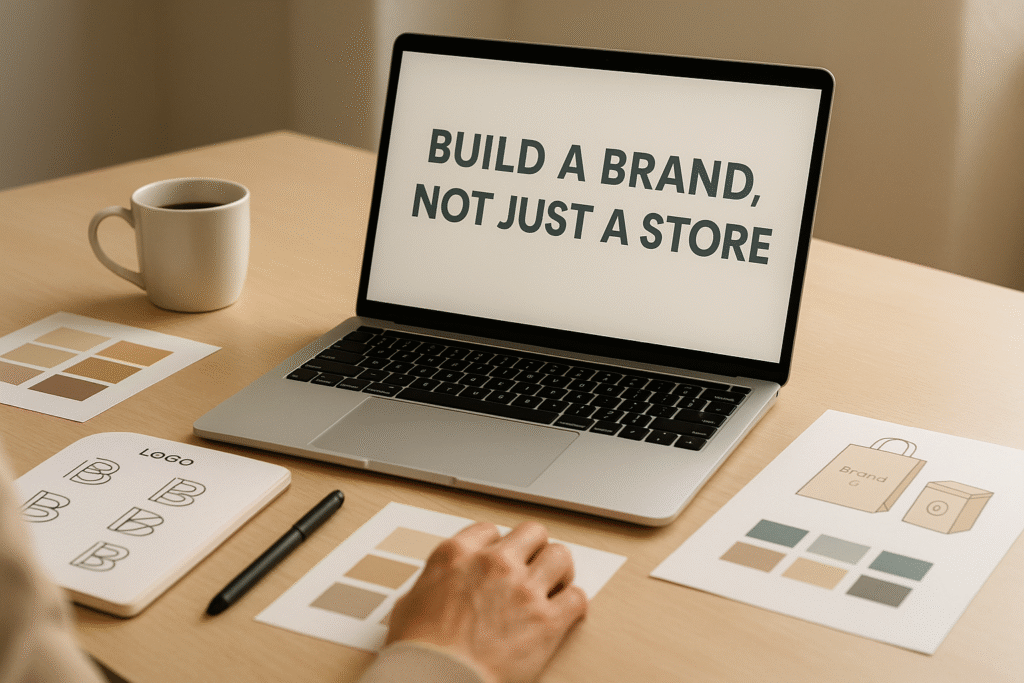Introduction
In e-commerce, anyone can open a store — but only few build a brand. A store sells products.
A brand sells identity, trust, and emotion.
In 2025, consumers don’t buy only items — they buy stories, values, and experiences.
If you want long-term success, repeat buyers, and loyal fans, you need a brand, not a store.
This guide will show you how to transform your online store into a powerful brand.
✅ Store vs Brand: Key Difference
| Feature | Store | Brand |
|---|---|---|
| Focus | Products | Experience & Identity |
| Customers | One-time buyers | Loyal returning customers |
| Marketing | Discounts, sales | Storytelling, community |
| Competition | Price war | Unique positioning |
| Lifetime Value | Low | High |
In short:
Store = what you sell
Brand = how people FEEL about what you sell
✅ Why Branding Matters
A strong brand gives you:
✔ Higher pricing power
✔ Loyal customers
✔ Consistent sales
✔ Better trust + credibility
✔ Strong social media presence
✔ Long-term business growth
Think about Nike, Apple, Zara —
Their success is branding, not just products.
✅ Steps to Build a Brand, Not Just a Store
1. Choose a Niche With Meaning
Instead of selling “everything,” choose a niche that connects with people.
Examples:
- Eco-friendly lifestyle products
- Fitness accessories brand
- Pet-care brand
- Luxury home decor brand
- Minimalist stationery brand
Niche gives identity.
2. Define Your Brand Story
People love stories.
Ask yourself:
- Why did you start?
- What problem are you solving?
- What values do you stand for?
Example brand message:
“We help people build healthier lives with natural products.”
Write a short story and add it to:
- Website homepage
- About page
- Social media bio
- Packaging inserts
3. Create a Memorable Brand Identity
This includes:
✔ Logo
✔ Brand colors
✔ Typography
✔ Tagline
✔ Website style
✔ Product packaging style
Tools for branding:
- Canva
- Looka
- Brandmark.io
- Figma
Consistency builds memory.
4. Know Your Audience Deeply
A brand understands its customers:
- What do they want?
- What do they struggle with?
- What motivates them?
Create a buyer persona:
Example: 22-30 yr old fitness lovers focused on healthy lifestyle & gym accessories.
5. Develop a Unique Selling Proposition (USP)
USP answers:
Why should someone choose you?
Examples:
- 100% eco-friendly products
- Handmade luxury items
- Personalized items
- Expert-backed skincare
USP makes you unique.
6. Build Trust Through Content
Content marketing builds brand authority.
Post content like:
- Tutorials
- Explainer videos
- Customer reviews
- Behind-the-scenes
- Founder story
- Value-based reels
- Tips and education
Platforms:
- YouTube
- TikTok
- Blogs
7. Packaging & Customer Experience
Branding isn’t just marketing — it’s how customers FEEL.
Give:
✅ Beautiful packaging
✅ Personal thank-you card
✅ Small surprise / freebie
✅ Fast support
This makes customers return and recommend.
8. Build Community
Brands don’t build audiences.
Brands build communities.
Ways to build community:
- WhatsApp groups
- Facebook groups
- Email newsletter
- Discord group
Share value, not just promotions.
9. Influencers & UGC
Use creators to build trust fast.
Micro influencers (1k–50k followers) work best for niche brands.
Also collect UGC (User Generated Content) to show real use cases.
10. Be Consistent
Branding is not one post or one month.
Branding = consistent identity + value over time
Results compound.
✅ Branding Mistakes to Avoid
❌ Selling random trending products
❌ Cheap brand identity
❌ No story
❌ No niche
❌ Copying competitors
❌ Only running discounts
Focus on value + trust + story.
✅ Success Examples
- Gymshark → built around fitness community
- Glossier → skincare brand built through social content
- Meesho sellers building niche female-focused fashion brands
These didn’t start big — they started with community + identity.
✅ Conclusion
Anyone can build a store.
Successful entrepreneurs build brands that people remember, love, and trust.
Branding is long-term — but once built, it becomes your strongest business asset.
Start today with:
- Niche
- Story
- Visual identity
- Content
- Community
- Consistency
Your store becomes a brand when customers feel connected to it.


